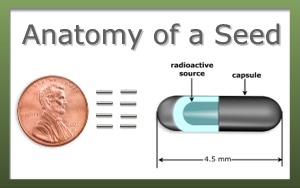|
|
Implant Procedure
A seed implant is a one-time out-patient procedure that takes less than an hour. Men typically report to the hospital in
the morning, and return home a few hours later the same day. Most men return to their normal activities within 24 hours. The
entire procedure is done through very thin needles; so there is no cutting involved and no stitches are required. The procedure
is done under either a light general or spinal anesthetic, so there will be no discomfort from the needles.
With an ultrasound in the rectum, a live picture of the prostate is obtained, and the needles can be precisely placed by
the Urologist through the perineum (the skin between the scrotum and rectum). The Radiation Oncologist then inserts the seeds
through the needles. Following the successful placement of seeds in the prostate, all the needles will be removed. Once the
anesthesia has worn off, you can go home. Many men return to their normal activities that next morning, and can return to
work, playing golf, etc.
|
 Click image for larger view
Click image for larger view |
↑ BACK TO TOP
..............................................................................................................................................................
Possible Side EffectsMost men experience only temporary side effects after the implant. Because there are no
incisions or stitches required, there should only minimal discomfort after the procedure. The most common complaint is temporary
irritation of the urinary stream lasting only for a few months. It is common to experience varying degrees of increased urinary
urgency and frequency. Medications can be given to help alleviate these symptoms. Long term side effects after the seed implant
are very uncommon. Unlike surgery, 99% of men are continent and completely able to control their urination. In addition, up
to 90% of men treated with a seed implant can preserve their sexual potency (ability to have erections). By precisely placing
the seeds in the prostate with the Procision™ technique, the incidence of seed migration outside the prostate is less
than 1%. The likelihood of radiation causing any serious damage to any surrounding tissues outside the prostate is consequently
minimal in our hands.
↑ BACK TO TOP
..............................................................................................................................................................
|
|
The Procision™ Technique differs greatly from the much older “pre-planned or Seattle technique.” The pre-plan technique
involves mapping out the prostate a few weeks in advance by ultrasound. Then, when the patient goes to the operating room,
the prior ultrasound is used to determine where to place the needles and seeds. The pre-plan technique unfortunately does
NOT take into account any differences in the size, shape, or position of the prostate at the actual time of surgery. It has
been our experience that the prostate can be very different at the time of surgery. Subtle changes in leg position, the degree
of bladder filling, the use of anesthesia, and the shape of your prostate after the needles are inserted can have profound
effects, making a pre-plan virtually useless.
In contrast, using powerful computers and experience based on thousands of previous cases, the Procision™ Technique takes
all of the above possible changes into effect. All of the needles and seeds are placed based on how the prostate looks at
the time of the procedure, not how it looked weeks before. The doses of radiation to the various areas are calculated live,
in Procision™.
|
|
Intra-operative computer planning
Our physicians have helped pioneer the use of powerful computers during the implant procedure to instantly calculate the
dose of radiation received by the prostate and surrounding areas. The computer can obtain and analyze live images of the prostate
gland throughout the implant procedure to further ensure optimal seed distribution and placement. This is a major improvement
over older techniques where the amount of radiation received by the prostate could not be determined until after all the seeds
were implanted.
|
|
↑ BACK TO TOP
..............................................................................................................................................................
|
